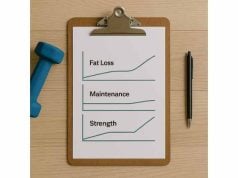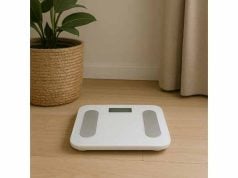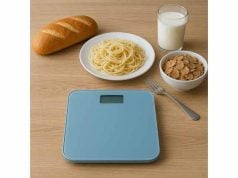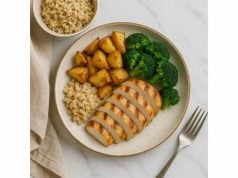
Weighing yourself can feel like guesswork. One day you are down a kilogram; the next you are up even after a careful week. Most of those swings are not fat—they are shifts in water, glycogen, and sodium. Once you learn how these variables behave, the “mystery” spikes calm down, and you can judge progress by trends instead of single mornings. This guide explains what is changing, why it changes, and how to measure fat loss reliably. If you are troubleshooting a stubborn plateau, pair this article with our practical plateau troubleshooting and maintenance guide so your next steps match the data, not the noise.
Table of Contents
- Water, glycogen and sodium basics
- Why the scale is not moving
- How carbs and salt change weight
- Training, stress and water
- Menstrual cycle and water shifts
- Alcohol, travel and late meals
- Two-week protocol to read trends
- Frequently Asked Questions
Water, glycogen and sodium basics
Your scale weight has two stories layered together. The slow story is fat and lean tissue—changes that happen over weeks. The fast story is fluid balance and food in transit—changes that happen within hours. Understanding the fast story prevents overreactions that derail the slow story.
Glycogen binds water. Muscles store carbohydrate as glycogen, and each gram of glycogen holds several grams of water inside the muscle. After higher-carb meals or reintroducing starches, you will often see a 1–3 kg uptick that is almost entirely water plus the food still in your gut. It is normal and transient. After a few lower-carb days or a longer workout, the reverse happens: you “lose” weight quickly as glycogen and its water are used.
Sodium regulates distribution. Your body keeps blood sodium within a tight range. Eat more sodium and your body retains water for a day or two to dilute it. Eat less sodium (or sweat a lot), and you release water. Large restaurant meals, cured meats, ramen, or salty sauces can shift scale weight overnight with little to no impact on fat stores.
Water follows stress. Poor sleep, new training volume, alcohol, and travel raise stress hormones and inflammation, which nudge your body to hold water. That extra fluid often sits in the tissues you are focused on—waist, hips, or thighs—so clothes may feel tighter even when you are sticking to your plan.
Food mass matters. High-fiber meals, late dinners, and “volume foods” expand gut contents. You literally weigh more because there is more food and water inside you. That is not failure; that is digestion.
What to do with this knowledge
- Shift attention to weekly averages rather than single weigh-ins.
- Track waist and navel once per week alongside daily weights.
- Expect water-driven swings whenever you change carbs, salt, training, or sleep.
- Learn the range of your own normal (most people see 0.3–1.0% of body weight up or down day to day).
If you are new to energy balance and habit setup, skim our concise weight loss fundamentals so your routines support clear, consistent data.
Why the scale is not moving
When the number refuses to drop, ask two questions: Is it a fluctuation or a true stall? and Are my behaviors consistent enough to tell? Most “stalls” are really masking events, where water and gut content hide fat loss for a few days. A true stall is different: two to four weeks of flat weekly averages and no change in waist/hip measurements with steady steps, protein, sleep, and training.
Common masking events
- High-sodium meals or late dinners. Expect a bump for 24–72 hours.
- Carb reintroduction after lower-carb days or a refeed—glycogen and water refill muscles.
- New training stress or soreness—tissue repair drags water into the muscle.
- Poor sleep or high stress—hormonal shifts affect water retention and digestion timing.
- Menstrual phase—many experience a predictable rise pre-period and a drop at onset.
Checklist before you declare a stall
- Do you have seven daily weigh-ins to average this week?
- Did you measure waist and navel under the same conditions?
- Are steps and protein consistent? (A drop in either can stall progress.)
- Did you log weekend eating with the same care as weekdays?
What separation looks like in data
- Fluctuation: weight average is flat but waist drops 0.5–1.5 cm; photos and clothes look tighter yet leaner; you can point to sodium, sleep, or training as short-term causes.
- Stall: weekly averages and waist remain unchanged for 2–4 weeks with steady behavior—time to adjust the plan.
If you need a simple, calm morning routine to collect clean data, use our step-by-step daily weigh-in protocol. It shows you how to standardize timing, clothing, and logging so small changes actually mean something.
How carbs and salt change weight
Carbohydrates and sodium are the two fastest levers for water shifts. Knowing their effects helps you interpret “spikes” without panic.
Carb-driven water changes
- Glycogen refill: After pizza night or a higher-carb day, muscles store more glycogen and pull in water. The scale may rise 1–3 kg within 24 hours. That is energy storage, not fat gain.
- Low-carb drop: After a few lower-carb days, you burn glycogen and release water. The quick drop feels exciting but does not reflect extra fat loss.
Why we keep carbs near training
Carbs around workouts support performance and recovery, and intramuscular water actually improves leverages and bar speed for many lifters. If you push carbs earlier in the day and near sessions, you get the benefits with fewer late-night cravings.
Sodium-driven water changes
- Restaurant meals: Oils, sauces, cured meats, and broths are salt-heavy. Weight commonly bumps for 1–2 days.
- Home cooking: Stable sodium day to day makes trends easier to read.
- Hydration: Drink fluids consistently. Big swings in water intake create their own noise.
Practical plays
- If you reintroduce carbs after a lower-carb run, expect a temporary jump. Judge progress by two to four-week averages.
- When eating out, plan protein and veggies first. Accept the water bump; resume routine; watch the average settle.
- Use the same salt habit most days (e.g., salting to taste at home). Precision is less important than consistency.
Want a crash course on what to expect when you bring back bread, pasta, or rice after a cut? See our plain-English note on the typical carb reintroduction spike: what is normal and temporary.
Training, stress and water
Training is good stress, but it is still stress. New volume, novel exercises, or hard eccentrics create micro-damage that attracts water to the muscle as part of repair. Combine that with life stress and short sleep, and you have the perfect recipe for a higher scale reading despite solid adherence.
Training effects
- DOMS and inflammation: Water rushes in to support repair, lifting the number for 24–72 hours.
- Creatine loading: A small, harmless increase in body water inside the muscle that often improves performance.
- Deload weeks: The scale sometimes drops simply because you retain less water.
Life stress and sleep
- Short nights increase hunger and slow digestion; you may also snack later, adding gut content to the scale.
- High work stress raises water retention in subtle ways. The result: you are leaner than the scale suggests.
Action steps
- Keep hard leg sessions away from measurement days if fluctuations bother you.
- Standardize weigh-in timing (after restroom, before food, same clothing).
- Prioritize 7–9 hours in bed, limit late caffeine, and add a short walk after dinner to improve sleep.
If sleep and recovery are the weak link in your plan, work through the targeted fixes in sleep, cortisol and stalled fat loss. Better sleep trims water noise and makes the scale more honest.
Menstrual cycle and water shifts
Many women see predictable, cycle-linked weight swings. Recognizing the pattern protects your mindset and stops unnecessary plan changes.
Typical pattern (varies by person)
- Follicular phase (post-period): lower water, easier weigh-ins.
- Luteal phase (pre-period): higher water, cravings, slower digestion; clothes may feel snug; weight rises.
- Onset of bleeding: a rapid drop is common as water releases.
How to measure progress fairly
- Track cycle day in your log. Compare cycle-matched weeks (e.g., week 2 this month vs. week 2 last month), not random weeks.
- Use waist/navel measurements and photos as primary metrics in the luteal phase.
- Avoid drastic calorie cuts during predictable water rises; they backfire by increasing cravings and stress.
Nutrition pointers
- Anchor protein early in the day (25–40 g at breakfast and lunch).
- Increase fiber and fluids to offset constipation in the luteal phase.
- Keep a planned evening snack (fruit + yogurt, or cottage cheese + berries) to prevent late raids.
If phantom plateaus hit the same time each month, you are not alone. Read our quick explainer on cycle-related water retention and stop mistaking water for fat.
Alcohol, travel and late meals
Weekends, flights, and social dinners are the most common sources of scale confusion. They cluster multiple water-shifting factors at once: alcohol, salty food, late eating, low sleep, and low steps.
Alcohol’s double effect
- Dehydration then rebound: The morning after drinks, you may weigh less (water loss), then rebound higher a day later when hydration and salty food catch up.
- Sleep disruption: Alcohol reduces sleep quality, which increases water retention and appetite the next day.
Travel variables
- Air travel: long sitting, cabin pressure, and different time zones encourage fluid shifts.
- Restaurant patterns: oils and sauces are calorie-dense and sodium-rich.
Late meals
- More food mass in your gut at bedtime equals a heavier morning. Shift the same meal earlier and the weigh-in looks different—proof that timing, not fat, moved the number.
Make the scale boring again
- Set a step floor during weekends and trips (e.g., 8–10k). Pair it with one short walk after your largest meal.
- Choose one indulgence per meal (drink, dessert, or fries) rather than all three.
- Keep protein first at restaurants; add veggies and a starch; ask for sauces on the side.
- Expect a 48–72 hour settling period when you return home.
For targeted weekend fixes that protect your weekly average, start with the simple plays in alcohol and weight stalls.
Two-week protocol to read trends
You do not need perfect data—just consistent data. This two-week protocol makes scale noise manageable and decisions simple.
Daily (2 minutes)
- Weigh in after the restroom, before food or drink, same minimal clothing, same scale, same spot on the floor.
- Log the number immediately.
Weekly (15 minutes)
- Compute the weekly average from seven daily weights.
- Measure waist and navel under the same conditions.
- Note steps (7-day average), protein average, and sleep hours.
- Take or review progress photos with the same lighting and distance.
Decision rules (repeat every two weeks)
- Average down OR waist down: stay the course.
- Average flat AND waist down: likely recomposition; hold steady.
- Average flat AND waist flat: confirm behaviors (steps, protein, sleep). If consistent, adjust one lever:
- Add +1,000–2,000 steps/day or two 20–30 minute easy cardio sessions.
- Trim 100–200 kcal/day from carbs or fats (not protein).
- If fatigue is high, try a short diet break at maintenance for 1–2+ weeks.
What to expect from noise
- Sodium/carb spikes: up for 1–3 days; ignore unless the weekly average also rises.
- Hard training: higher for 1–2 days after new volume; look at the next average.
- Cycle phase: compare cycle-matched weeks.
Simple template (copy/paste)
- Weekly weight average:
- Waist (narrow/navel):
- Steps (7-day avg):
- Protein (g/day avg):
- Sleep (hours avg):
- Notes (sodium, training, cycle day, travel):
- Decision for next two weeks:
Keep your eye on averages and measurements. One noisy morning is not a verdict—it is just data.
Frequently Asked Questions
Why did my weight jump after a salty or high-carb meal?
Sodium and carbs pull water into your tissues and refill glycogen, which stores extra water. Expect the scale to rise for 24–72 hours. That is not fat. Resume your routine, keep steps up, and judge by the weekly average and waist measurements.
How much can normal water fluctuation change my weight?
Day-to-day shifts of 0.3–1.0% of body weight are common, especially after hard training, poor sleep, or restaurant meals. These changes reflect water and food mass, not fat. Track daily, average weekly, and compare two- to four-week trends for a fair assessment.
Why is my weight flat but my waist is smaller?
You are likely recomposing—losing fat while maintaining or gaining a little muscle or water. That is progress. Keep protein high, training steady, and steps consistent. Use waist, photos, and clothes fit as primary markers alongside weekly weight averages.
Do late dinners make me gain fat or just weigh more?
Late meals increase gut content at weigh-in, so you weigh more the next morning. That is not fat gain. If late meals are unavoidable, standardize your weigh-in routine and judge progress with weekly averages and measurements instead of single days.
How should I weigh to reduce noise?
Weigh daily, right after the restroom, before food or drink, in minimal clothing, on the same scale and surface. Log it and compute weekly averages. Pair the scale with waist measurements and a step/protein/sleep snapshot to connect inputs to outcomes.
What role does the menstrual cycle play in weight?
Many experience a rise in the luteal phase and a drop near onset. Track cycle day and compare cycle-matched weeks month to month. Use waist and photos more heavily during pre-period weeks to avoid mistaking water retention for fat gain.
References
- Hydration, Hyperthermia, Glycogen, and Recovery 2023 (Systematic Review & Meta-analysis)
- Effects of Sodium Intake on Health and Performance in Endurance and Ultra-Endurance Sports 2022 (Systematic Review)
- Changes in body weight and body composition during the menstrual cycle 2023 (Observational Study)
- Pathophysiology of Exercise-Induced Muscle Damage and Its Structural, Functional, Metabolic, and Clinical Consequences 2020 (Review)
- Common questions and misconceptions about creatine supplementation: what does the scientific evidence really show? 2021 (Review)
Medical Disclaimer
This article explains how fluid shifts affect daily scale readings and how to track fat loss more accurately. It is for general education only and is not a substitute for professional medical advice, diagnosis, or treatment. Always consult your licensed clinician before changing your diet, exercise, or medications.
Share and Follow
If this helped you make sense of scale swings, please share it with someone who needs a calmer, data-first approach to progress. You are welcome to follow us on Facebook, X, or whichever network you use most for practical, step-by-step guides and updates.










